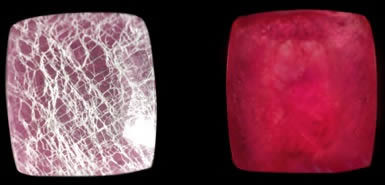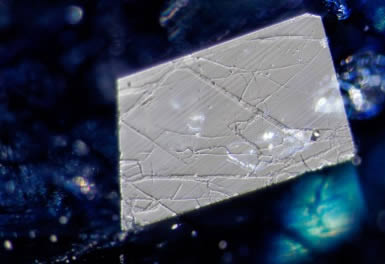Composite Gemstones
Why Your Jewellery Purchase May Be Too Good To Be True

We've all heard the saying, ‘If something seems to good to be true, then it probably is’. In recent years, as valuers, we have seen an increase in the number of composite gemstones being unscrupulously sold as natural rubies and sapphires (both varieties of the corundum gem species). This article aims to provide you with information on these composites and what to look out for when making a purchase.
It is estimated that over 95% of the rubies and sapphires sold today are heat-treated. This is a standard practice in the industry and improves the colour and the clarity of the stone. Most importantly this is considered a stable treatment and permanent.
Introduction to Market
In 2004 a new type of treatment in rubies was reported by the Gemmological Association of All Japan (GAAJ). This treatment saw low-quality corundum with multiple surface-reaching fractures, or cracks, being heated and filled with a coloured high lead content glass (pictured below). This improved the apparent clarity and transparency of the stone, whilst helping the gem cutter achieve a higher yield (the percentage of the rough crystal which remains after cutting into a polished gemstone).

In 2007, cobalt-glass sapphires were developed using a similar technique with colourless corundum. This treatment differs from the traditional glass-filling of corundum - seen since the 1980s, as the glass content is often 30-40% of the finished gemstone. It is important to note, however, that neither of these treatments are regarded as trade standard and they should be disclosed by the seller. The main reason for this is that the glass filler is unstable and can be damage or degrade over time. Ultrasonic cleaners with ammonia solution, household cleaning products and jewellers' pickle (a acidic solution used to remove oxides after soldering) are all likely to cause irreparable damage to the stone.
Identification
Composite stones can be identified by several features, some of which with the aid of a 10x loupe. Firstly, the surface of the stone should be observed for changes in the lustre. The lustre of a gemstone is the quality and quality of light reflected from the surface of the material. In the case of composite stones, the glass filler is softer and has a lower lustre than its host gem and where the glass reaches the surface, this can easily be seen by moving the stone around in the light. You will see a pattern similar to that shown in the image below:


Another feature of glass-fillers is a colour flash. This flash will often be blue in a ruby and pink in sapphire. This may even be seen by the naked eye, dependent on the size of the stone and location of the fractures. In the case of cobalt-glass filled sapphires, veins or concentration of blue may be visible. See the right-hand image above.

A natural ruby or sapphire will never have gas bubbles present as internal features. As soon as these are seen, alarm bells will ring. In the case of these glass-filled stones, air can become trapped in the fracture with the glass. These bubbles may be perfectly round or flattened.
Due to the initial quality, fragile nature and instability of these gemstones, their value is a mere fraction of their natural counterparts. For this reason, it is extremely important to know what you are purchasing. There has been an increase in these types of stones being seen on the market in the US and on cruise ships, often mis-sold as natural and with no information on the treatment being disclosed.
Larger and high-quality gemstones after often accompanied by a laboratory report from institutes such as the Gemmological Institute of America (GIA), Gübelin, GemResearch Swisslab (GRS) amongst others. These reports often provide details of any treatments which have been carried out on the gemstone and note the dimensions. In some cases, these also provide an origin report, which can add value. It is, however, wise to research the laboratory providing the report as standards and expertise can vary.
So - if you want to make sure your new piece of jewellery is not too good to be true - ask questions and use your observation skills. If you are in doubt, speak to a qualified and experienced jewellery valuer or gemmologist who will be glad to assist you.

Author
- Sammantha Maclachlan MJVA, FGA, PJDip, CPAA
- Independent Jewellery Valuer
- Paisley, UK
- Sammantha Maclachlan FGA Ltd
Topics
- Gems / Gemmology (primary)
- Jewellery
Intended Audience
- Consumers (primary)
- Retailers
- Insurance Professionals
- Gemmology Academics
Content
- June 2020
- 4 mins reading time
- Dale-Chall readability level:
Easily understood by an average College Student - 5.5 mins speaking time
- 0 Comments
About the Author
Share
Share this page on your favourite networks



Comments
To avoid spammers, your comment or question will published after it has been checked.
Consumer advice can be found in the Consumer Resources section, this contains information to assist the jewellery-buying public, for example: Types of Jewelry Appraisals and Jewelry Trade Asociations etc.





